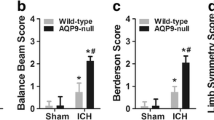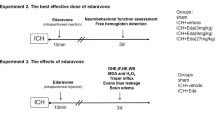Abstract
Edema formation has been linked to thrombin toxicity induced by blood clot at the acute stage of intracerebral hemorrhage. Thrombin induces cell toxicity in neuron, microglia and astrocyte. Aquaporin (AQP) 4 and 9 are proteins expressed on astrocyte in rat brain and involved in the brain water accumulation in brain edema. Recombinant hirudin (r-Hirudin) is a direct inhibitor of thrombin that can block the toxicitic effect of thrombin. In this study, we demonstrated that autologous whole blood infusion in caudate nucleus up-regulates the expression of AQP4 and AQP9 mRNAs and proteins. AQP4 and AQP9 mRNAs expression peaked at about 6 h after blood infusion. The AQP4 protein peaked at about 48 h while AQP9 at about 24 h after blood infusion. Thrombin induced up-regulation of AQP4 and AQP9 were inhibited by r-Hirudin administration and significantly decreased the expression of both AQPs. We further investigated the relationship between edema formation and expression of AQP4 and AQP9. The data presented here may be helpful in optimizing r-Hirudin as an anti-thrombin drug in the treatment of edema at the acute stage of ICH.





Similar content being viewed by others
References
Lee KR, Colon GP, Betz AL et al (1996) Edema from intracerebral hemorrhage: the role of thrombin. J Neurosurg 84(1):91–96
Xi G, Wagner KR, Keep RF et al (1998) Role of blood clot formation on early edema development following experimental intracerebral hemorrhage. Stroke 29(12):2580–2586
Loret C, Sensenbrenner M, Labourdette G (1989) Differential phenotypic expression induced in cultured rat astroblasts by acidic fibroblast growth factor, epidermal growth factor, and thrombin. J Biol Chem 264(14):8319–8327
Gurwitz D, Cunningham DD (1988) Thrombin modulates and reverses neuroblastoma neurite outgrowth. Proc Natl Acad Sci USA 85(10):3440–3444. doi:10.1073/pnas.85.10.3440
Lee KR, Betz AL, Keep RF et al (1995) Intracerebral infusion of thrombin as a cause of brain edema. J Neurosurg 83(6):1045–1050
Lee KR, Betz AL, Kim S et al (1996) The role of the coagulation cascade in brain edema formation after intracerebral hemorrhage. Acta Neurochir (Wien) 138(4):396–401. doi:10.1007/BF01420301
Venero JL, Vizuete ML, Machado A et al (2001) Aquaporins in the central nervous system. Prog Neurobiol 63(3):321–336. doi:10.1016/S0301-0082(00)00035-6
Badaut J, Petit JM, Brunet JF et al (2004) Distribution of aquaporin 9 in the adult rat brain: preferential expression in catecholaminergic neurons and in glial cells. Neuroscience 128(1):27–38. doi:10.1016/j.neuroscience.2004.05.042
Jung JS, Bhat RV, Preston GM et al (1994) Molecular characterization of an aquaporin cDNA from brain: candidate osmoreceptor and regulator of water balance. Proc Natl Acad Sci USA 91(26):13052–13056. doi:10.1073/pnas.91.26.13052
Venero JL, Vizuete ML, Ilundain AA et al (1999) Detailed localization of aquaporin-4 messenger RNA in the CNS: preferential expression in periventricular organs. Neuroscience 94(1):239–250. doi:10.1016/S0306-4522(99)00182-7
Hiroaki Y, Tani K, Kamegawa A et al (2006) Implications of the aquaporin-4 structure on array formation and cell adhesion. J Mol Biol 355(4):628–639. doi:10.1016/j.jmb.2005.10.081
Nielsen S, Nagelhus EA, Amiry-Moghaddam M et al (1997) Specialized membrane domains for water transport in glial cells: high-resolution immunogold cytochemistry of aquaporin-4 in rat brain. J Neurosci 17(1):171–180
de Castro Ribeiro M, Hirt L, Bogousslavsky J et al (2006) Time course of aquaporin expression after transient focal cerebral ischemia in mice. J Neurosci Res 83(7):1231–1240. doi:10.1002/jnr.20819
Ishibashi K, Kuwahara M, Gu Y et al (1998) Cloning and functional expression of a new aquaporin (AQP9) abundantly expressed in the peripheral leukocytes permeable to water and urea, but not to glycerol. Biochem Biophys Res Commun 244(1):268–274. doi:10.1006/bbrc.1998.8252
Tsukaguchi H, Shayakul C, Berger UV et al (1998) Molecular characterization of a broad selectivity neutral solute channel. J Biol Chem 273(38):24737–24743. doi:10.1074/jbc.273.38.24737
Amiry-Moghaddam M, Lindland H, Zelenin S et al (2005) Brain mitochondria contain aquaporin water channels: evidence for the expression of a short AQP9 isoform in the inner mitochondrial membrane. FASEB J 19(11):1459–1467. doi:10.1096/fj.04-3515com
Hamada R, Matsuoka H (2000) Antithrombin therapy for intracerebral hemorrhage. Stroke 31(3):791–795
Markwardt F (1994) The development of hirudin as an antithrombotic drug. Thromb Res 74(1):1–23. doi:10.1016/0049-3848(94)90032-9
Koster A, Kuppe H, Hetzer R et al (1998) Emergent cardiopulmonary bypass in five patients with heparin-induced thrombocytopenia type II employing recombinant hirudin. Anesthesiology 89(3):777–780. doi:10.1097/00000542-199809000-00029
Lubenow N, Eichler P, Lietz T et al (2004) Lepirudin for prophylaxis of thrombosis in patients with acute isolated heparin-induced thrombocytopenia: an analysis of 3 prospective studies. Blood 104(10):3072–3077. doi:10.1182/blood-2004-02-0621
Mehta SR, Eikelboom JW, Rupprecht HJ et al (2002) Efficacy of hirudin in reducing cardiovascular events in patients with acute coronary syndrome undergoing early percutaneous coronary intervention. Eur Heart J 23(2):117–123. doi:10.1053/euhj.2001.2731
Choi TS, Khan AI, Greilich PE et al (2006) Modified plasma-based ecarin clotting time assay for monitoring of recombinant hirudin during cardiac surgery. Am J Clin Pathol 125(2):290–295. doi:10.1309/0TDG-8BEC-LWCB-XCDK
Steinbrich W, Gross-Fengels W, Krestin GP et al (1990) Intracranial hemorrhages in the magnetic resonance tomogram: studies on sensitivity, on the development of hematomas and on the determination of the cause of the hemorrhage. Rofo 152(5):534–543
Lin TN, He YY, Wu G et al (1993) Effect of brain edema on infarct volume in a focal cerebral ischemia model in rats. Stroke 24(1):117–121
Yang GY, Betz AL, Chenevert TL et al (1994) Experimental intracerebral hemorrhage: relationship between brain edema, blood flow, and blood-brain barrier permeability in rats. J Neurosurg 81(1):93–102
Xi GH, Keep RF, Hua Y et al (1999) Attenuation of thrombin-induced brain edema by cerebral thrombin preconditioning. Stroke 30(6):1247–1255
Arima H, Yamamoto N, Sobue K et al (2003) Hyperosmolar mannitol stimulates expression of aquaporins 4 and 9 through a p38 mitogen-activated protein kinase-dependent pathway in rat astrocytes. J Biol Chem 278(45):44525–44534. doi:10.1074/jbc.M304368200
Koeppen AH, Dickson AC, McEvoy JA (1995) The cellular reactions to experimental intracerebral hemorrhage. J Neurol Sci 34(suppl 1):102–112. doi:10.1016/0022-510X(95)00215-N
Karabiyikoglu M, Hua Y, Keep RF et al (2004) Intracerebral hirudin injection attenuates ischemic damage and neurologic deficits without altering local cerebral blood flow. J Cereb Blood Flow Metab 24(2):159–166. doi:10.1097/01.WCB.0000100062.36077.84
Donovan FM, Pike CJ, Cotman CW et al (1997) Thrombin induces apoptosis in cultured neurons and astrocytes via a pathway requiring tyrosine kinase and RhoA activities. Neuroscience 17(14):5316–5326
Ke C, Poon WS, Ng HK et al (2001) Heterogeneous responses of aquaporin-4 in oedema formation in a replicated severe traumatic brain injury model in rats. Neurosci Lett 301(1):21–24. doi:10.1016/S0304-3940(01)01589-0
Kiening KL, van Landeghem FK, Schreiber S et al (2002) Decreased hemispheric aquaporin-4 is linked to evolving brain edema following controlled cortical impact injury in rats. Neurosci Lett 324(2):105–108. doi:10.1016/S0304-3940(02)00180-5
Badaut J, Hirt L, Granziera C et al (2001) Astrocyte-specific expression of aquaporin-9 in mouse brain is increased after transient focal cerebral ischemia. J Cereb Blood Flow Metab 21(5):477–482. doi:10.1097/00004647-200105000-00001
Hua Y, Xi G, Keep RF et al (2000) Complement activation in the brain after experimental intracerebral hemorrhage. J Neurosurg 92(6):1016–1022
Xi GH, Hua Y, Richard FK et al (2001) Systemic complement depletion diminishes perihematomal brain edema in rats. Stroke 32(1):162–167. doi:10.1161/hs1201.099820
Manley GT, Fujimura M, Ma T et al (2000) Aquaporin-4 deletion in mice reduces brain edema after acute water intoxication and ischemic stroke. Nat Med 6(2):159–163. doi:10.1038/72256
Rash JE, Yasumura T, Hudson CS et al (1998) Direct immunogold labeling of aquaporin-4 in square arrays of astrocyte and ependymocyte plasma membranes in rat brain and spinal cord. Proc Natl Acad Sci USA 95(20):11981–11986. doi:10.1073/pnas.95.20.11981
Papadopoulos MC, Manley GT, Krishna S et al (2004) Aquaporin-4 facilitates reabsorption of excess fluid in vasogenic brain edema. FASEB J 18(11):1291–1293
Badaut J, Regli L (2004) Distribution and possible roles of aquaporin 9 in the brain. Neuroscience 129(4):971–981. doi:10.1016/j.neuroscience.2004.06.035
Acknowledgments
This study was supported by grants D200530 from the Province Nature Science Foundation.
Author information
Authors and Affiliations
Corresponding author
Additional information
Zhe Sun and Zhenhuan Zhao contributed equally to this article.
Rights and permissions
About this article
Cite this article
Sun, Z., Zhao, Z., Zhao, S. et al. Recombinant hirudin treatment modulates aquaporin-4 and aquaporin-9 expression after intracerebral hemorrhage in vivo. Mol Biol Rep 36, 1119–1127 (2009). https://doi.org/10.1007/s11033-008-9287-3
Received:
Accepted:
Published:
Issue Date:
DOI: https://doi.org/10.1007/s11033-008-9287-3




